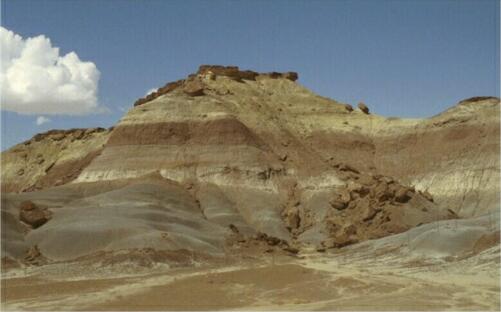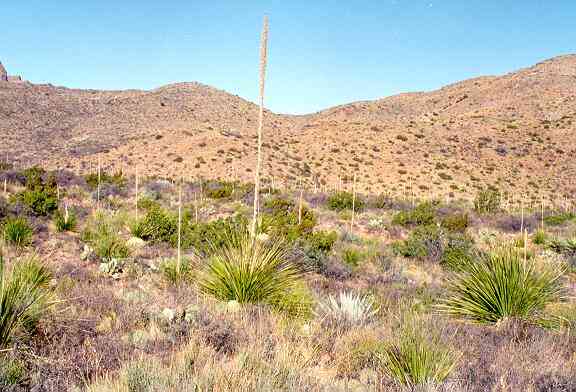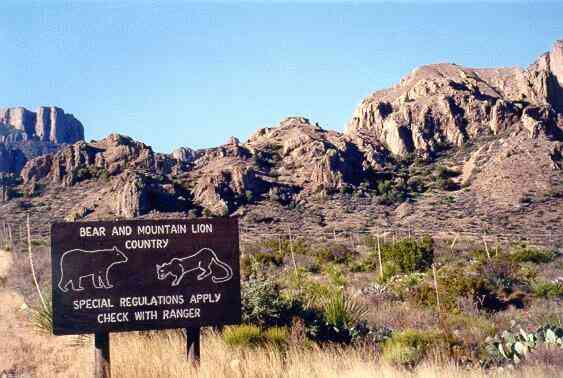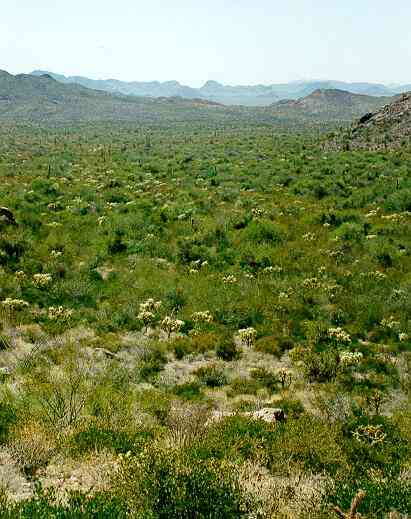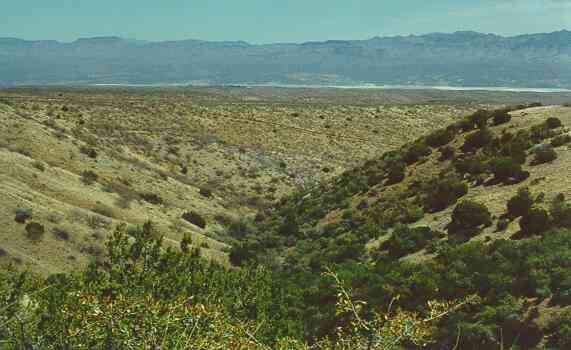| DESERT ECOLOGY: INTRODUCTION Ecology is the study of the relationships of living organisms with one another and with their environment. It is a scientific subject but also one that most of us can relate to and understand. with each other. It is the study of integration - how the components fit together as a whole. This website deals with the ecology of deserts, using examples from the four major desert types of North America - the Great Basin Desert, Sonoran Desert, Chihuahuan Desert and Mojave Desert . We consider all the major types of organism -
We also consider the major environmental conditions that create deserts and that influence the types of organism that live in these environments - the climate and the soils derived from different types of rock. _____________________________________________________ |
| What is a
desert? Deserts are dry places - places where the scarcity of water is the main factor that governs the abundance and types of organism that can live there. [For more details and technical definitions, see Deserts Defined]. Almost invariably, the organisms found in deserts are specially adapted to avoid or withstand extended periods of drought. The 'avoiders' include plants that respond to occasional periods of rain by emerging from dormant seeds, growing rapidly, flowering and then rapidly producing seeds again. These plants can give produce spectacular carpets of blooms for short periods of time. The 'withstanders' include plants that persist for many years and have special adaptations for tolerating extended periods of drought. The cacti are well-known examples, but many less spectacular plants are equally well adapted - for example, the creosote bush in the image below. This can be the dominant shrub over extensive areas of North American deserts. The desert animals .........
Deserts are diverse Deserts are asonishingly diverse, and often far from barren. The desert scene in the image below could not be more different from the area of creosote bush above - and it is only a few kilometres away! Here we see several large cacti and a profusion of leafy shrubs and small trees. In this case the difference is caused mainly by a difference of soil type. The creosote bush thrives on well-drained areas of flat or sloping land - often with an underlying compacted soil layer of calcium (called caliche). Beneath the gravelly surface the soil consists of tightly packed sand and silt particles, with very little organic matter. These soils do not retain much water. In contrast, the larger cacti and leafy shrubs in the scene below are most common on bajadas - areas where the soil is quite deep, with a mixture of particle sizes, ranging from boulders down to silt. These soils retain water within the soil profile and support a wide diversity of plants.
Here the annual rainfall is as much as 12 inches per year, and it occurs in two distinct periods - during late winter and also during summer. The greater soil porosity enables much of the water to penetrate the soil, and the vegetation is unusually lush. Even so, all these plants are specially adapted to withstand periods of drought stress: the cacti have succulent tissues for water storage; the other larger shrubs such as palo verde (the small tree behind the standing figure) and ocotillo (the wand-like plant in the right foreground) have photosynthetic stems, not leaves, for most of the year; the low-growing, grey-green shrub (bursage) over most of the soil surface has hair-covered leaves that shrivel in periods of drought.
Desert plant adaptations Desert plants can be grouped into three broad categories in terms of their adaptations to water shortage. Escapers, such as annuals, have seeds that lie dormant for several years. When they germinate the plants grow rapidly, then flower and set seed within a few weeks. Evaders, such as ocotillo, are perennials that drop their leaves or go into state of dormancy when water is deficient. Resisters, such as cacti and many desert shrubs, are adapted to minimise water loss (e.g. by having small leaves or photosynthetic stems) or have succulent tissues to store water. Many of these plants also have crassulacean acid metabolism (CAM) - a specific adaptation for conserving water. In CAM plants the stomata remain closed by day, to prevent water loss, but open at night to admit CO2. The CO2 is combined with the 3-carbon compound, phospho-enol-pyruvate, to form 4-carbon organic acids such as oxaloacetic acid and malic acid. Essentially this is a method of storing CO2. Then, during the day (when the stomata are closed) CO2 is released from the organic acids and used for synthesis of sugars in the Calvin cycle. Desert plant communities Shown below are a few characteristic desert scenes, illustrating the diversity of desert communities. Creosote bush is among the commonest plants in lowland regions of the warmer North American deserts. Creosote bush thrives on well-drained areas of flat or sloping land - often with an underlying compacted soil layer of calcium (called caliche). Beneath the gravelly surface the soil consists of tightly packed sand and silt particles, with very little organic matter. These soils do not retain much water, so the plants are widely spaced, with extensive root systems to capture the available soil water. (Click here for more images and details). In stark contrast, the scene below shows a rich assemblage of larger cacti and leafy shrubs. Again, this is in the lower Sonoran region of the Arizona desert, but on a bajada - a sloping area where the soil is quite deep, with a mixture of particle sizes, ranging from boulders down to silt. These soils retain water within the soil profile and support a wide diversity of plants. Even so, all these plants are specially adapted to withstand periods of drought stress: the cacti have succulent tissues for water storage; the other larger shrubs such as palo verde (the small tree behind the standing figure) and ocotillo (the wand-like plant in the right foreground) have photosynthetic stems, not leaves, for most of the year; the low-growing, grey-green shrub (bursage) over most of the soil surface has hair-covered leaves that shrivel in periods of drought. The transition between different types of vegetation can be very sharp if there is a change in slope or soil type, as seen in the scene below. Here the large cacti and shrubs of the slope of a bajada have been replaced by a mixture of bursage and creosote bush as the slope flattens and the soil has smaller particles with low water-retention (foreground). The large saguaro cactus in the forground is clearly unhealthy - possibly due to frost damage.
Another type of transition is seen in the image below, where the land at the foot of a bajada is flat and consists mainly of silt and sand. In this case the soil is calcareous and subject to intense evaporation of water from the surface, leading to a high surface salt content. An occasional large cholla cactus (e.g. the jumping cholla, in the centre) or mesquite tree (far right) can occur in such regions but the dominant plants are saltbush (the grey-green shrub, Atriplex polycarpa) and a low-lying cholla cactus - the devil club (foreground, Opuntia stanlyi and related species). These are among the few plants that thrive in salty, alkaline conditions. As the land starts to rise in the middle distance we see a green zone of palo verde and saguaro cactus. Effects of soil, slope, water and elevation The availability of water derived from rainfall (or sometimes dew) is the single most important factor that determines desert life. But other factors such as soil, elevation and slope interact with water to influence the vegetation. Soil Three clear examples of soil effects are shown in the images below. In this image (above) we see a marked transition of vegetation over a distance of less than 30 metres. In the foreground the land slopes gently and is composed mainly of sand and gravel. It is dominated by bursage and cholla cactus. As the land rises up a bajada (with rocks and stones and thus greater water penetration into the soil) we see a zone of palo verde and the large saguaro cacti.
"Badlands" such as the region shown above in Arizona are areas where the rainfall is critically low and the soil has little water-holding capacity, and often may have toxic levels of mineral nutrients. Such areas are almost totally devoid of vegetation Elevation Elevation has a great influence on the climate in the warmer latitudes where most deserts are found: in general, for every 1000 feet rise in elevation the temperature -----. The cooler temperatures and lower rates of evaporation can lead to desert grassland communities like the one below in the Chihuahuan desert.
In this image we thick-leaved succulent plants such as sotol (with the flowering spike in the centre of the image), aloes (e.g. the grey-green plant to the right of the sotol), prickly pears (left of the sotol) and woody shrubs.
The larger animals of the desert mountains make sorties into these shrubby and wooded areas, to find food. Notable among them are black bears and mountain lion.
Near the bases of the mountains that surround many of the desert regions of North America, the finer soil particles from erosion of the mountain rocks are washed down to the foot of canyons, producing alluvial fans which support a rich community of woody shrubs. This is shown in the image above (Sonoran upland region), where the dominant shrub is jojoba, interspersed with cholla cacti. Jojoba grows at altitudes up to about 1500 metres (5000 feet).
Various small-treed oaks (such as Gambel oak, in the right and left foreground above) and shrubs such as Ephedra (the "joint firs", in centre foreground) grow at these and higher altitudes. Mule deer browse these plants.
In all regions where water is the critical limiting factor for growth, the aspect of a site can have major influence. This is clearly shown here, ascending the mountains above the Sonoran desert, where the mixed shrub and tree community of pinyon pine and oaks is largely confined to the north-facing slope (right of the image) which is less exposed to intense sunlight. GO TO: |



